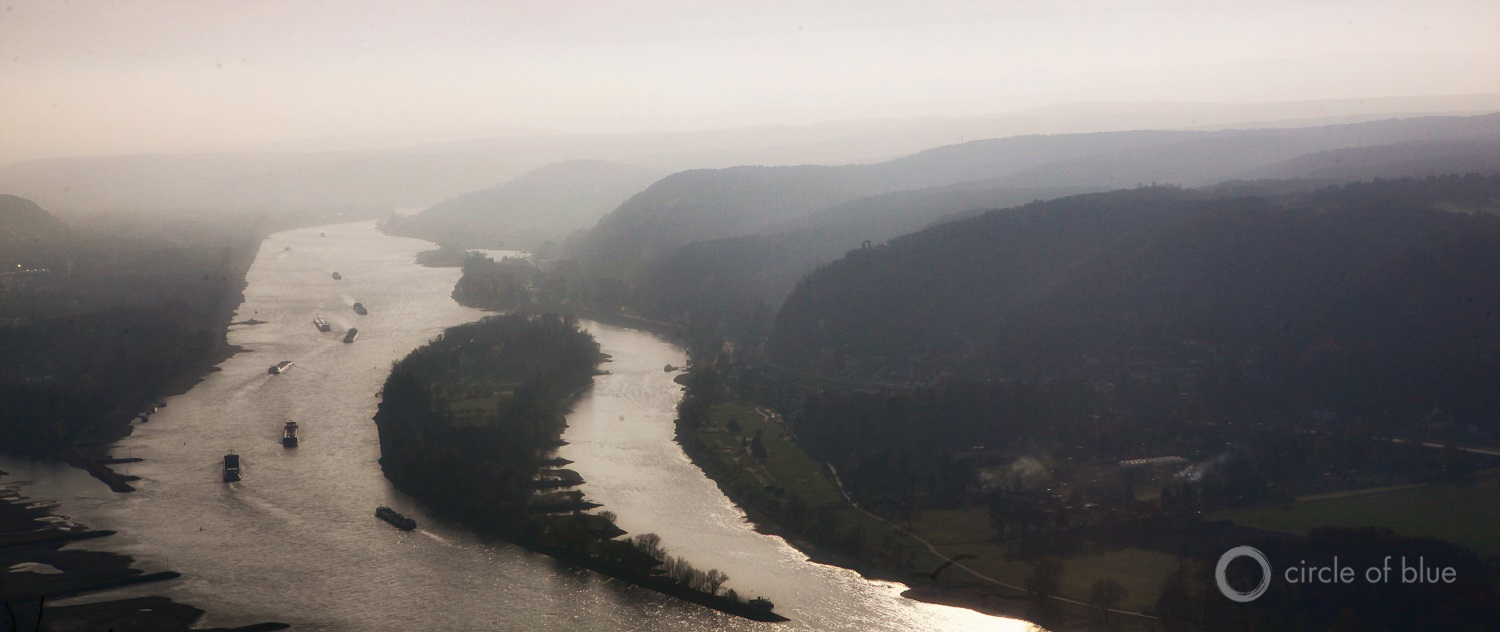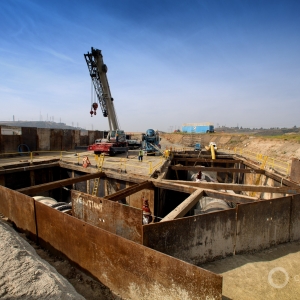Global water security is increasingly threatened. Accounting for water use and risk ought to have the same urgency with which we address carbon.

Cargo ships on the Rhine River, in Germany. Photo © J. Carl Ganter/Circle of Blue
By Jay Famiglietti, Jose Ignacio Galindo, Palash Sanyal, and Li Xu – April 7, 2022
Provocative? Perhaps. But true.
When it comes to acknowledging society’s impact on climate, environment, and human security, water is the next frontier for comprehensive accounting and adaptation strategies — for industry, municipalities, governments, and individuals, all of which have made impressive commitments and progress to track carbon pollution.
However, our increasingly threatened global water security demands that accounting for water use and risk rapidly acquire the same urgency with which we address carbon.
The paths of our water and climate journeys have led us to one abundantly clear realization. Since industry accounts for over 80 percent of water withdrawals worldwide, it will be impossible to significantly move the needle on global water security without deep engagement by the private sector. This will require new strategies by industry and investors for valuing and protecting water, the ecosystem services it provides, and its cultural importance.
Steps to Water Stewardship
It is essential that industry and investors acknowledge their impacts on water quality and accessibility, including the rapidly growing risks of climate change, and realistically account for their impacts using the best available science. It is clearly in industry’s best interest to do so, since the cost of inaction on water risk is five times greater than the cost of action.
There are several steps that industry can take to champion water stewardship.
First, monitoring and transparent reporting of water use at the facility level and across supply chains, using frameworks such as those provided by CDP and TCFD, are crucial. Uniform disclosure standards should ultimately be adopted. The newly established International Sustainability Standards Board can play a pivotal role in ensuring the development of such standards. This step also should include board-level accountability for water operations, and a goal of returning to the environment the same amount of water that was withdrawn — at the same quality or better.
Second, investors must also champion water stewardship by demanding the same level of accountability for water as they do for carbon. The University of Saskatchewan’s upcoming report with the sustainability non-profit Ceres reviewed and summarized the voluminous scientific evidence on industry impacts on water, including threats, risks, and climate change. It can be a guidebook for investors who want to have transformative discussions with companies about their expectations for valuing the real material risks of water.
Third, industry should work with governments, researchers, and nonprofits to spearhead public awareness campaigns that bring water into climate change discussions alongside carbon, and that elevate understanding of our rapidly changing water landscape, just as has been done for carbon dioxide budgets, sources, and sinks. This includes supporting region-specific or national policies that protect and sustain water. These policies must accommodate the just and equitable use and allocation of water — for humans, municipalities, environment, industry, economic growth, and energy production.
Finally, while the private sector has a critical role to play, consumers do as well. Industry should expect that consumers will increasingly demand transparent disclosure on water use and efficiency, and will purchase goods and services based not only on a company’s its carbon footprint but also its water footprint and reputation.
Warnings Unheard
Humanity’s relationship with water has always been complicated. We vigorously protect drinking water supplies, and we work diligently to prevent the frequent ravages of flooding and drought. Yet at the same time, we have over-pumped aquifers, and to varying degrees in history and geography, we have treated rivers and groundwater as personal, public, or industrial dumping grounds.
The harsh reality of human behavior is that safe thresholds for the quality of the world’s rivers and groundwater were exceeded decades ago, while on the quantity side, over half of the world’s major aquifers have now exceeded tipping points for sustainability and are being quickly depleted.
The rapid pace of climate change is both its own threat, and a threat multiplier. It is increasing the strength of extremes like flooding and drought; it is changing global patterns of freshwater availability and accessibility; and it is driving unsustainable overuse of groundwater in water-scarce regions. Simultaneously, it is significantly worsening water pollution, for example, when toxic contaminants stored on land are dangerously dispersed during floods, or when discharge to rivers and groundwater is insufficiently diluted during drought.
Almost everywhere on Earth is subjected to at least one of the trio of unfortunate water realities: too much, too little, too dirty. According to the UN, half of the global population now lives in regions that experience severe water scarcity at least one month per year, and more than 80 percent of the world’s wastewater — sewage, commercial, industrial, and agricultural discharge — is returned to rivers and groundwater untreated.
While carbon dioxide emissions are driving the rapid increase in global temperatures, water is the messenger that delivers the catastrophic impacts of climate change to your home, your business, and your community. The problem is that, throughout history, we have been ignoring the messenger.
As scientists, it is exceptionally frustrating that our community’s warnings about our collective global water future go largely unheard. While some progress is being made — for example, California’s Sustainable Groundwater Management Act, or Canada’s new, public-private insurance program for flooding — the global water crisis is getting worse, not better. The pace and scale of society’s response to the world’s growing water threats are shockingly inconsistent with the pace and scale required to address them.
It’s time to treat water like we treat carbon. The time for action on carbon has been widely and successfully accepted. The time for action on water is now.
Jay Famiglietti is executive director of the Global Institute for Water Security (GIWS) at the University of Saskatchewan, and he serves as chief scientist of Waterplan. Jose Ignacio Galindo is co-founder & CEO of Waterplan. Palash Sanyal is the strategic partnership and project manager at GIWS, and Li Xu is a postdoctoral researcher there. Both are members of Waterplan’s science team.



